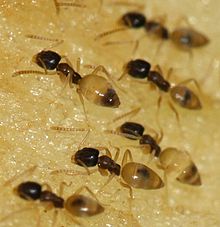Tapinoma melanocephalum
| Ghost ant | |
|---|---|

| |
| Workers feeding on apple | |
| Scientific classification | |
| Domain: | Eukaryota |
| Kingdom: | Animalia |
| Phylum: | Arthropoda |
| Class: | Insecta |
| Order: | Hymenoptera |
| Family: | Formicidae |
| Subfamily: | Dolichoderinae |
| Genus: | Tapinoma |
| Species: | T. melanocephalum
|
| Binomial name | |
| Tapinoma melanocephalum (Fabricius, 1793)
| |
| Subspecies | |
| |
| Synonyms | |
| |
Tapinoma melanocephalum is a species of ant that goes by the common name ghost ant. They are recognised by their dark head and pale or translucent legs and gaster (abdomen). This colouring makes this tiny ant seem even smaller.[1]
Description

The ghost ant is small, with average lengths ranging between 1.3 to 2.0 millimetres (0.051 to 0.079 in) in workers.
The queens are similar in appearance to a worker, but the alitrunk (
Distribution and habitat
Due to how widespread the ghost ant is, the exact native range is not exactly known.
The species is a common pest in the United States, particularly in the states of Hawaii and Florida, although the species is expanding further north, even reaching Texas by the mid 1990s.[10] They are commonly found in the southern parts of Florida, and is considered a key pest, along with several other invasive ant species.[11] The earliest record of the ghost ant in the United States was in 1887, where the species was found in Hawaii.[12] It was then recorded in Washington, D.C. in 1894.[13] After these two records, the ghost ant would later be found in Maine, New York, Connecticut, Virginia, North Carolina, Georgia, Florida, Illinois, Michigan, Wisconsin, Minnesota, Iowa, Missouri, Louisiana, Texas, Kansas, New Mexico, Arizona, California, Oregon and Washington.[9][14] Ghost ants can be found in the U.S. territories of Puerto Rico and the U.S. Virgin Islands.[15]
References
- ^ a b c Collingwood, C.A. (1979). "The Formicidae (Hymenoptera) of Fennoscandia and Denmark". Fauna Entomologica Scandinavica. 8: 1–174. Retrieved 5 February 2015.
- ^ a b c d Creighton, W.S. (1950). "The ants of North America". Bulletin of the Museum of Comparative Zoology. 104: 1–585. Retrieved 5 February 2015.
- ^ a b Smith, Eric H.; Whitman, Richard C. (1992). NPCA Field Guide to Structural Pests. Dunn Loring, Virginia: National Pest Control Association.
- ISSN 0015-4040.
- OCLC 6078460. Retrieved 31 December 2014.
- OCLC 560205. Retrieved 6 February 2015.
- ^ Ayre, G.L. (1977). "Exotic ants in Winnipeg, Manitoba". Entomologist. 11: 4111–4144.
- JSTOR 2388026. Retrieved 6 February 2015.
- ^ a b Wetterer, James K. (2012). "Worldwide spread of the ghost ant, Tapinoma melanocephalum (Hymenoptera: Formicidae)". Myrmecological News. 12: 23–33. Retrieved 6 February 2015.
- ^ Chenault, E.A. (1997). "Ghost ants now in Texas". Texas AgriLife Research News. Retrieved 6 February 2015.
- JSTOR 3495674.
- ^ Blackburn, T; Cameron, P. (1887). "On the Hymenoptera of the Hawaiian Islands". Memoirs of the Manchester Literary and Philosophical Society. 10: 194–244.
- ^ Pergande, Theo (1896). "Mexican Formicidae". Proceedings of the California Academy of Sciences. 5 (2): 858–896.
- ^ King, R.L. (1948). "A tropical ant temporarily established in Iowa". Proceedings of the Iowa Academy of Science. 55: 395.
- ^ Forel, Auguste H. (1881). "Die Ameisen der Antille St. Thomas". Mitteilungen der Münchener Entomologischen Verein. 5: 1–16.
External links
- Tapinoma melanocephalum on the UF / IFAS Featured Creatures Web site
